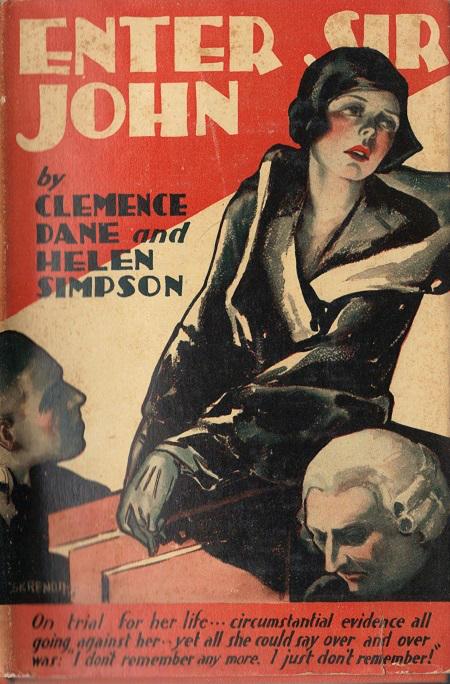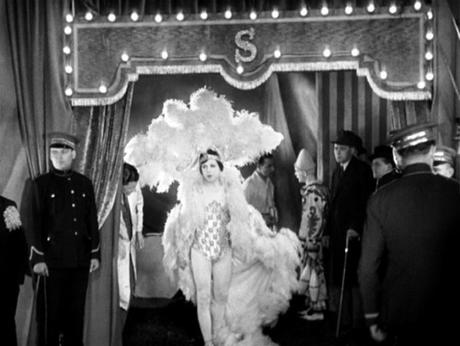
Enter Sir John is a detective story. It’s a book I’ve mildly wanted to read for many years, ever since seeing Murder!, the slightly odd 1930 film that Alfred Hitchcock based on the novel.
The story begins in the town of Peridu, where a troupe of touring actors are presenting a play at the local theater. At night, screams are heard; there is consternation and one of the actresses is lying dead, while another, Martella Baring, is standing by her, looking dazed, with the murder-weapon poker on the ground beside her.
(Warning: Spoilers ahead!)
The dazed actress goes to trial, and her only defence is that she cannot remember what happened in the crucial minutes between the beginning of her conversation with the other woman and her coming to in an incriminating position.
She is found guilty, but the trial attracts the attention of Sir John Saumerez, an actor-manager of the Gerald du Maurier type, suave, sophisticated and used to being obeyed. He feels an interest because Martella (a girl of ‘breeding’, we are told several times) had once come to him asking for an acting job, and he had told her to go and gain a year’s experience in the provinces. He attends the trial, and is so concerned when she is found guilty and condemned to death, that he goes to the town of Peridu to do some detective work, accompanied by Markham, the troupe’s stage manager.
It is one of those murder mysteries that is not much of a mystery. Several of the male members of the company might have been possible suspects, but they are eliminated fairly quickly, and it becomes obvious that the killer is Handell Fane. It is just a matter of proving it. In an Agatha Christie novel, this would have just been a red-herring, and all the evidence that seemed to point to Fane would be shown to actually incriminate someone else altogether. No such luck here. The book just plods along.
Sir John traps him by imitating the play scene in Hamlet. Fane is asked to audition for a part, and is given a script that resembles what must have happened on the night of the murder. This is a bit stagey, but then the whole novel is stagey: every chapter in preceded by an epigraph of a couple of lines of Shakespeare.
It isn’t a very well-constructed book. The first half builds up the character of Sit John, and of Martella Baring, and of a few of the troupe of actors, but not the suspects, so it doesn’t really matter to the reader which of them did it. Handell Fane only becomes interesting later, when we learn his motive for murdering the woman. He is frightened that she was about to reveal his secret – that his mother was Eurasian, and he was therefor mixed race. Is this really a motive for murder, even in 1929?
There are also hints that during the war he had ‘lost his nerve’ somehow, but not much is made of this. Clelmence Dane does like to seem up-to-date in psychological matters. There is a fair bit of stuff about Martella having entered a ‘fugue state’ at the time of the murder.
Having read the book, I watched the Hitchcock film again (It’s on YouTube). It’s actually very close to the book, except that it livens it up. For example, in the book the evidence from the various actors comes in rather plodding examinations in court; Hitchcock has the police interview them backstage during the play, which means that after a few questions they have to suddenly get into character for the farce they are in and go ontage to act. It’s a cleverly done scene. It also makes us notice Handell Fane at the start, because he is a man dressed as a woman. When we meet him later his manner is effeminate – so Hitchcock seems to be suggesting he is not only of mixed race but also of intermediate sexuality. There is nothing of this in the novel. Hitchcock also gives him a spectacular death, whereas in the novel he is allowed to disappear.

Hitchcock’s Handell Fane – a cross-dressing trapeze artist.
Hitchcock also increases Sir John’s motivation by making him a member of the jury at Martella’s trial. He is forced to agree that the evidence they have heard proves she is guilty, so does not stand up against the other eleven. After the trial, though, he has the motivation of wanting to right a wrong which he has been complicit in.
Both book and film are solidly snobbish. It’s signalled from the start that Martella must obviously be worth saving because she has ‘breeding’ – she is a soldier’s daughter. There are easy condescending laughs at the expense of the actors in the run-down theater troupe, and the landladies who give them lodgings. Sir John is adored by everyone, including the authors. I think they seem to share the characters’ horror at the thought of a white woman marrying an Asian.
So – it’s one of those books more interesting as revealing social attitudes than as a novel. Other members of the group found much to admire in other works by Clemence Dane, but on this evidence I don’t think that she and Helen Simpson were very good at writing detective novels. They wrote two more, though.
